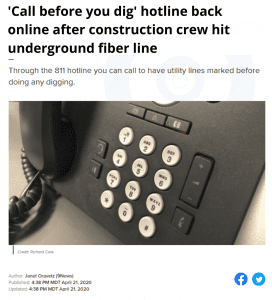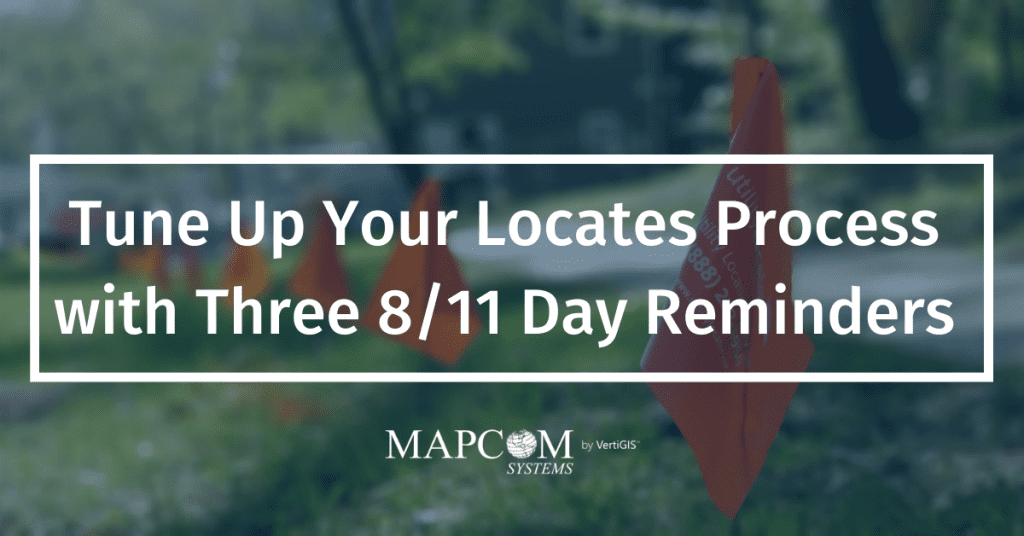According to the Common Ground Alliance, an underground utility line is damaged every six minutes – potentially causing serious personal harm and expensive property damage that leaves telecommunications companies, electric cooperatives, and other utility providers working to identify and repair underground facilities. With utility providers relying on these buried lines to provide essential services to their customers, and their customers relying on them to stay up and running, it is vital to remember those four very important words, call before you dig.
 Each year since 2009 on August 11 or 8/11, underground facilities protection agencies come together to remind their communities to notify their local one-call agency before digging, doing home renovation projects, or using excavation equipment – no matter how small the task. Failing to do so can result in damage that impacts service to others in the community, sometimes including the 811 call centers themselves.
Each year since 2009 on August 11 or 8/11, underground facilities protection agencies come together to remind their communities to notify their local one-call agency before digging, doing home renovation projects, or using excavation equipment – no matter how small the task. Failing to do so can result in damage that impacts service to others in the community, sometimes including the 811 call centers themselves.
In honor of 8/11 day, we’re highlighting three things providers can continue to do to help keep their networks safe and their customers online.
1. Educate Your Residential Customers on the 811 Process
While you won’t be assisting your customers in their latest quarantine home renovation project – your utility lines could ultimately pay the price if homeowners aren’t properly informed. Many providers use 8/11 Day and April, designated as National Safe Digging month, as a time to educate their communities on the importance of calling before you dig. Now is your chance to highlight the importance of submitting a request and share the process of submitting a request over the phone or online. This could be a fun video, a press release in your local newspaper, or a community event that illustrates just what happens when you don’t use proper locating or excavating practices. Empowering you customers with these important facts can help you and your utility lines stay intact through every home renovation.
2. Keep Your Network Maps Up-To-Date
One of the most important steps of responding to locates requests is correctly identifying your facilities in the area that needs markings. This process depends on having accurate records of where utility lines are located in your network mapping system. Inaccurate or incomplete data can lead to improperly marked areas that inevitably cause costly damages to your network and cause service disruptions for your customers. By keeping network maps updated – locates requests can be addressed quickly and with greater accuracy, reducing the time in-house and third-party locators spend qualifying, working, and closing locates tickets.
3. Continuously Evaluate Damage Prevention Workflows and Processes
Oftentimes approaches for locates management are labor-intensive, manual processes filled with opportunities for error. Locate request emails can be overlooked in an inbox shared by multiple users, updated accidentally, or passed off to a locator that may not be near the site of the request or already saddled with too many tickets. This approach can become burdensome and ineffective in keeping your network online and your customers happy. There is no rule that says you have to keep with the status quo of processes that have come before you – evaluate what’s working well and highlight areas of growth that need changing. The ability to recognize areas of growth will allow you to identify new processes and technologies that can help improve the productivity and effectiveness of your damage prevention program.
Managing requests and marking all locates quickly and accurately in advance of a project is key to protecting your network from eager excavators. In a time where the need to stay online and connected is more important than ever before, Mapcom has introduced Pinpoint811 – an intelligent locates management tool – to help teams reduce the administrative effort required to protect your company from pricey line strike disasters. Pinpoint works alongside your network maps to visualize, evaluate and respond to all locates requests in a single interface, ensuring you never miss a ticket and can help prevent unexpected service disruptions for your customers.
We may only celebrate 8/11 day once a year, but it’s important for to remember to call every time you dig, whether you’re a homeowner or a construction crew. As for utility providers, correctly evaluating, marking, and completing requests in a timely fashion can help keep your communities connected and your underground facilities safe.

